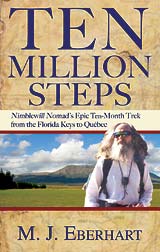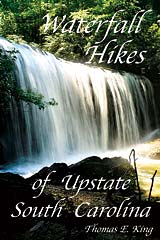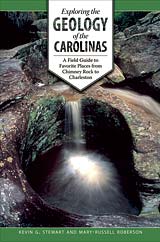Out on the trail, I spend a lot of time working out where I am. It gets even better when I understand what I’m seeing in the woods. And here in the Southern Appalachians, there is so much to see—from huge plutons to Fraser firs. But sometimes, when it’s cold and wet outside—hypothermia weather—I may opt to stay indoors and read about other people’s adventures. Here are some great gifts for the outdoors lover or dreamer on your list.

Ten Million Steps: Nimblewill Nomad’s Epic 10-Month Trek from the Florida Keys to Quebec by M.J. Eberhart (Menasha Ridge Press, 2007) $16.95.
Nimblewill Nomad’s first day on the Florida National Scenic Trail was only eight miles. I thought Florida was flat: Shouldn’t he have been able to double that mileage? But that year the trail was incredibly wet, and he had to ford streams and swim through portions of the route. By the time Nimblewill, a retired optometrist from Florida, gets to the start of the Appalachian Trail at Springer Mountain, Ga., he’s already walked 1,402 miles—a sobering thought.
Ten Million Steps chronicles his 4,400-mile hike via journal entries that are part trail descriptions, part musings with some poetry thrown in. His days aren’t all wonderful, and he doesn’t spare us the pain. “Today proves to be agonizing and slow. I’m enduring the foot pain but I’ve had to reduce my pace considerably,” he writes from Monson, Maine. When he reaches Mount Katahdin, he celebrates and then just continues walking into Canada on the International A.T. Nomad walked 4,404 miles, and he writes with conviction and humor. This is the book about long-distance walking that should have hit the international best-seller list. Dip into it day by day, or read it in one big gulp.

Waterfall Hikes of Upstate South Carolina by Thomas E. King (Milestone Press, 2006) $17.95.
Sometimes Upstate South Carolina doesn’t get the respect it deserves. But with many sections of the Blue Ridge Parkway closed for the winter and snow on Cold Mountain, now is the time to appreciate the Upstate. In the Blue Ridge Escarpment, nearly every river, creek or stream forms a waterfall at some point. King highlights many that are bound to be new to most North Carolinians. You may know about Whitewater Falls (the highest in the eastern U.S.), a two-part formation in both North and South Carolina. But pssssst: Check out Moonshine Falls on the Asbury Hills Camp property, where hiking is open to the public.
King identifies 92 waterfalls in the Upstate, which he rates on both appearance and accessibility. Take his trail ratings with a grain of salt—remember, he’s writing for families, not experienced hikers—but his driving and trail directions are precise, and his small black-and-white photos are helpful in determining whether you want to visit a particular waterfall. This book is a good resource for families with small children. Adults may enjoy the walking and solitude, but children need a destination—a purpose for going into the woods. In addition, most hikes are less than two miles roundtrip. King’s book is bound to become “the” waterfall book for the Upstate.

Exploring the Geology of the Carolinas: A Field Guide to Favorite Places from Chimney Rock to Charleston by Kevin G. Stewart and Mary-Russell Roberson. (UNC Press, 2007) $19.95.
The chimney in Chimney Rock State Park was “created when erosion took place along a zone of vertical fractures in the rock, creating a space between … gneiss and the rest.” What is gneiss? And what about the awesome granite dome of Stone Mountain in Wilkes County, which rises 700 feet above the valley floor? The book starts with a brief geological history of the Carolinas that’s written at a pretty basic level; no previous knowledge required.
But then comes the reward: 31 field trips to familiar sites in both states. Once there, you can trace the evidence of geologic change found in rocks, river basins, mountains, waterfalls and coastal land formations. “There aren’t many places on earth where you can see such geologic variety all within a day’s drive,” explains Kevin Stewart, a professor of geological sciences at UNC-Chapel Hill. “All of these different rocks and landscapes are part of a really interesting geologic story that begins almost two billion years ago.” Stewart is clearly enthusiastic about his subject, and Roberson, a science writer, ensures that complex ideas are explained in a way that’s intelligible to the general public. An invaluable glossary explains all these geologic terms, including gneiss—a coarse-grained, metamorphic rock with alternating bands of minerals.

A Nature Guide to Northwest North Carolina by Stewart Skeate (Parkway Publishers, 2004) $24.95.
Skeate, a biology professor at Lees-McRae College in Banner Elk, looks at his corner of the world from the North Carolina/Virginia border, through Boone and Linville, and on south of Linville Gorge. The book explains rocky outcrops, mountain bogs, plants and animals for a general audience. How do you tell a Fraser fir from a red spruce? The cones on a Fraser fir hang down, while those on a red spruce stand erect. “Northern hardwoods,” “mixed oak forests”—these ecological terms, often thrown around so casually, are meticulously described here. The author understands what his readers will find vexing. Beautiful color photographs help users identify flowers, salamanders and insects. Don’t let the small geographic focus put you off. This book will work just as well in understanding the Pisgah District and the Smokies.
Oh yes, my book, Hiking the Carolina Mountains (Milestone Press, 2007), would also make a great gift.
[Hike leader and outdoors writer Danny Bernstein can be reached at danny@hikertohiker.com]



Before you comment
The comments section is here to provide a platform for civil dialogue on the issues we face together as a local community. Xpress is committed to offering this platform for all voices, but when the tone of the discussion gets nasty or strays off topic, we believe many people choose not to participate. Xpress editors are determined to moderate comments to ensure a constructive interchange is maintained. All comments judged not to be in keeping with the spirit of civil discourse will be removed and repeat violators will be banned. See here for our terms of service. Thank you for being part of this effort to promote respectful discussion.